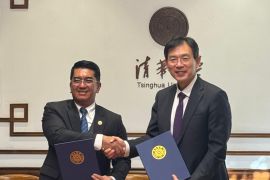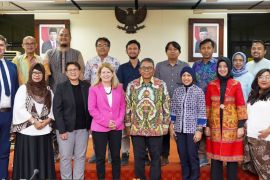Cluster one is filled with 13 top non-vocational higher educational institutions. They are regarded as Indonesia's top centers of excellence.
The universities belonging to this group comprise Bandung Institute of Technology (ITB), Gadjah Mada University (UGM), Bogor Agricultural University (IPB), Sepuluh Nopember Institute of Technology (ITS), and the University of Indonesia (UI).
Eight other members of this group are Diponegoro University (Undip), Airlangga University (Unair), Hasanuddin University (Unhas), Brawijaya University (Unibraw), University of Padjadjaran (Unpad), Andalas University (Unand), Sebelas Maret University (UNS), and University of Sumatera Utara (USU).
A majority of these centers of excellence are located in Java while other parts of Indonesia are only represented by three universities – Unhas in South Sulawesi Province, Unand in West Sumatra Province, and USU in North Sumatra Province.
This national university ranking is evidence of how serious the gap is in the quality of teaching, research, innovation, and community services at universities in Indonesia because the eastern part of the country is just represented by Unhas.
Meanwhile, the central part of this archipelagic state has no representative in the group of cluster one because the 12 remaining top universities are all situated in the western parts of Indonesia.
Examining the credibility of this Research, Technology, and Higher Education Ministry's national university ranking, it can, for instance, be compared to that of the Scimago Institutions Rankings.
According to Scimago Institutions Rankings, USU emerged as Indonesia's best higher educational institution in 2019 followed by UI and IPB coming in second and third.
Based in Medan, North Sumatra Province's capital city, USU bagged the top-ranking owing to its outstanding performance in research and enhancing innovation achievements, the Scimago Institutions Rankings revealed on its official website last April.
The seven other Indonesian universities among its 10 best are UGM, ITB, the Jenderal Soedirman University (Unsoed), the Syiah Kuala University (Unsyiah), Unibraw, Unair, and UNS.
This year's full listing of Indonesia's universities by the Scimago Institutions Rankings can be accessed on https://www.scimagoir.com/rankings.php?country=IDN&ranking=Research.
Developed by Scimago Lab through Scopus as its data source, the Scimago Institutions Rankings maintains that it is "a science evaluation resource to assess worldwide universities and research-focused institutions."
To decide on the ranking of academic and research-related institutions across several parts of the world, the Scimago Institutions Rankings applies a composite indicator that combines three diverse sets of indicators on the basis of research, performance, innovation outputs, and societal impact.
USU is one of Indonesia's public universities, whose foundation was initiated by the North Sumatra governor on June 4, 1952, to cater to the requirements of the province's locals.
However, it was Indonesia's first president Soekarno, who officially inaugurated USU as a public university on November 20, 1957. Thus, USU has turned out to be Indonesia's seventh public university.
The Indonesian Ministry of Research, Technology, and Higher Education's Sinta, or Science and Technology Index, which puts the spotlight on the performance of local universities in terms of research work indexed by Scopus over the last three years, ranked USU fourth as of August 26, 2019.
With reference to Sinta, 10 local universities delivering top-class scientific publications encompass the UI, UGM, ITB, USU, Unhas, IPB, ITS, Undip, Unibraw, and Unpad.
Referring to the evidence stated above, a gap of research achievement remains obvious among 13 members of the group of cluster one because Unair and Unand, for instance, do not belong to the list of top 10 universities based on research work indexed by Scopus.
Moreover, none of the best universities in Indonesia, including the ones in cluster one, has obtained a prestigious position in the list of the 100 of the world's best universities.
Instead, Singapore, a city-state whose total population is less than 5.7 million people, has been able to place its national university among the world's best higher learning and research-based institutions for many years.
Aware of the fact that none of Indonesia's leading universities is in the list of the world's 100 best universities, the Research, Technology, and Higher Education Ministry has been supporting the internationalization program of local universities.
The ministry has even shown its keenness to "import" foreign reputable academicians to lead several universities in Indonesia in the near future because that approach has commonly been found at universities in many countries, including Singapore.
The approach is also a part of the ministry's endeavors to accelerate Indonesia's ability to place certain universities among the world's 100 best universities and to serve its people with world-class higher education.
Incumbent President Joko Widodo (Jokowi) himself has pledged to focus on improving the quality of Indonesia's human resources amid fierce competition among nations in this digital era.
What Jokowi is keen to do to improve Indonesia's competitiveness in his second leadership term really depends on the quality of the country's educational institutions, including universities.
Of course, the related ministries and stakeholders have been challenged to resolve the gap of quality among local universities in Java and outside Java, and at the same time, to boost Indonesia's leading universities to obtain prestigious positions in the world.
Related news: Universities should strive to produce competent graduates: Minister
Related news: Over 60 rectors of Asia`s universities meet in Surabaya
Related news: Sri Mulyani backs government's plan to recruit foreign rectors
Editor: Gusti Nur Cahya Aryani
Copyright © ANTARA 2019












